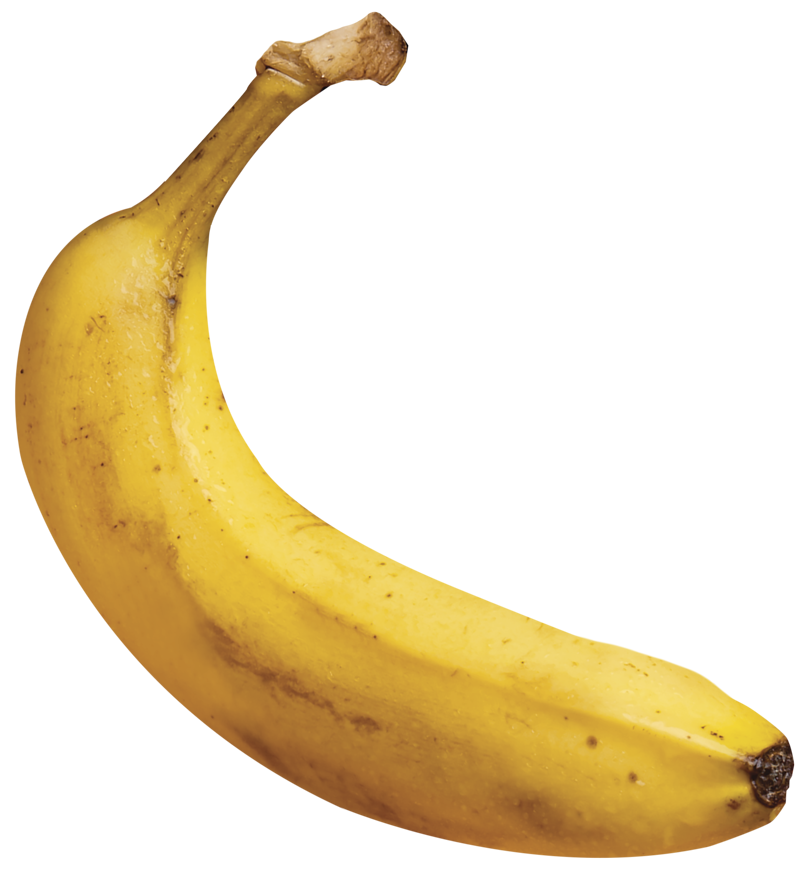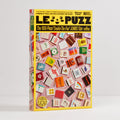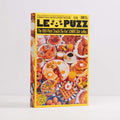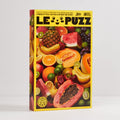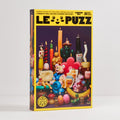7 Questions for Alistair Matthews and Michael Hunter
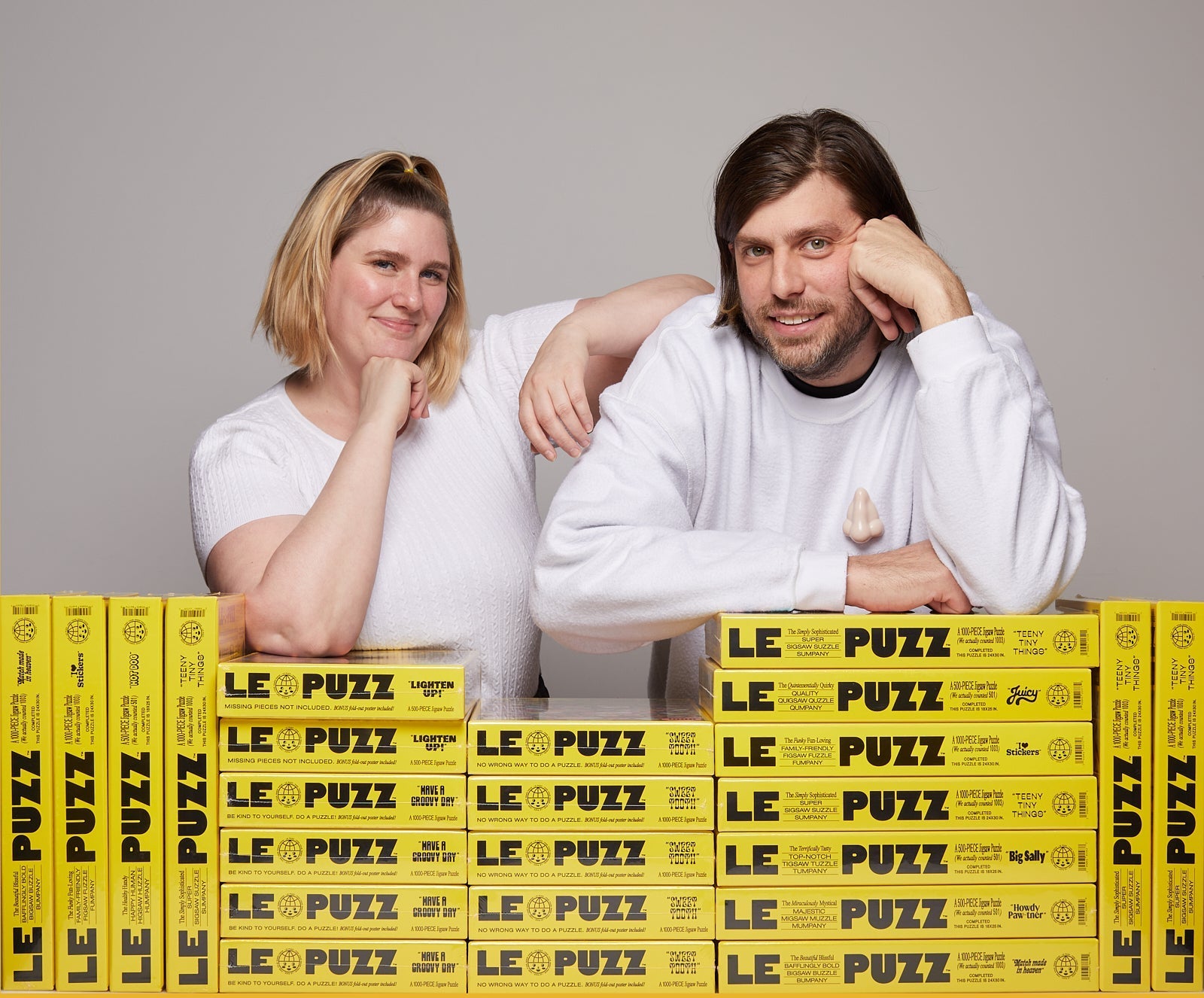
Interview by Chris Lucius
*How did you two go from loving puzzles to making your own?
A: It was 2020 during the early days of Covid lock-down and we were both doing a lot of puzzles. I had naturally turned to eBay, my favorite shopping site, and quickly discovered just how rich the history of vintage puzzles were. Michael had previously been worked for a company that among other things, made jigsaw puzzles. At some point in my eBay puzzle buying madness I came across a gem from 1991 called Midnight Delights. I texted Michael the image and suggested that he pitch the idea of making something like this to his former employer … but that I should photograph it, haha. He responded “Well, maybe we should just start a puzzle company!”. One thingled to another and thus began Le Puzz!

Above: BTS of Wakey Wakey



Above: images of Howdy Paw-tner, Me-ow Time, and series 1
We’ve been so lucky to build an amazing little team so we just keep chugging along.
More by Chris Lucius*What does an image absolutely need to make a great puzzle?
M: Lots of colors, shapes and patterns. Big areas of flat colors tend to be mind numbing
so we avoid those as much as possible. We like to add in a few repeating colors,
patterns or subjects here and there to confuse the puzzler, making it a little bit harder.
The image needs to be something you’re ok with looking at for several hours. Nothing
boring!
*Where do the ideas for your Le Puzz images come from? What is the process of
that idea becoming a final image for a Le Puzz puzzle?
A: The ideas come straight from our silly little brains. We’re artists by nature and met at
art school in Chicago so we tend to be wacky and out there with imagery. We both have
running lists of ideas on our Notes app on our phones and we are constantly suggesting
puzzle ideas that we’re the most excited about. The same goes for collaborators. When
we see someone whose work we love, we send it to each other and see if the other is
as excited.
M: An in-house Le Puzz image starts off by green lighting an idea. Usually the idea is
relatively clear and we know what it’ll look like in the end but sometimes props dictate
the final design. After we’re aligned on the general vision, Alistair will go to town tracking
down props, set pieces, doo-dads of all kinds. This is her favorite step. We come up
with a budget for the shoot and see who and what we can work with for that amount.
After we have acquired all of the pieces needed, we have a photoshoot in our office/
studio. Alistair is a professional photographer so she shoots everything. I always help
prop style and workshop ideas and work arounds for troubleshooting during the shoot.
Once we have an image we love, we place our die-line over the it to ensure it isn’t too
monochrome in places and that it looks like a fun puzzle! I then get to work on coming
up with a title, writing all of packaging copy and conceptualizing the games or direction
for the back of the box. Once we have all of that in order, we hand it over to our
designer, Noemie LeCoz of Little Troop, who lays out the entire box and brings it all to
life! Once a few rounds of proofing are done we send it into production and wait for the
final product. All together its about an 8-9 month process from idea to physical product.
The wheel never stops turning either, we always have a new series of puzzles to talk
about, a series thats in production and one that we are planning, our eyes are already
on 2027!
*Le Puzz puzzle pieces are unique and complexly shaped which makes for an
exciting construction. How do you create these individual shapes without
repeating a design?
M: Our piece shapes are very important to us. We use a random cut piece shape for all
of our puzzles, this is our favorite type of piece shape because of their blobby and
interesting forms. We find it easier to puzzle when you can look for piece shape and not
just at the image. We based the design of our die cuts after few of our favorite vintage
puzzle brands from the 70s. We tried quite a few times to hire someone to draw us a
die line it never turned out quite right, so we just learned how to do it ourselves! Alistair
draws all of the die-lines by hand and then we turn them over to our manufacturer who
employees many engineers. They make sure it’ll work from an engineering stand point,
and often suggest little changes here and there. Once approved for production the die is
painstakingly hand made! Think of it as a giant cookie cutter. Each bend his formed by
hand and the die will last for 100,000 cuts before it needs to be replaced. The whole
process is very old school, which we love.
*Le Puzz does something I’ve never known a puzzle company to do. If you
misplace a single piece, Le Puzz will send you that replacement piece. Have you
ever had two people missing the same individual piece?
A: Yes! We love that we’re able to do that! It was something that Michael was adamant
about us starting from the get go. I remember his talking about all the missing piece
emails that we fielded at his old job and how there was no remedy for it. He’d always
imagined some kind of file system where the pieces could be picked out if needed.
Currently, our system is that we have every single Le Puzz puzzle completed in our
studio. They’re all pressed between pieces of foam-core and lay flat. When someone
sends us a photo of a missing piece, we locate it in our copy and ship it out in a little
yellow ziplock bag. It’s very cute and we usually include a little note if we can.
We actually JUST had our first instance of replacing a piece that had already gone out.
It’s wild how long it took for that to happen tbqh. In this case we pulled out another copy
of the puzzle off our archive shelves and sifted through the pieces until we found the
right one. It takes a lot longer in that case but still worth it. That’s partly what’s so nice
about running your own company, doing something like this may seem like a hassle but
we love that it makes people happy and we hate a missing piece whether is was a cat, a
spill, a Roomba or a mysterious piece that just up and walked away. We hope that as
we grow it’s continues to be a service we can provide.
*What are the biggest changes that you can think of from when you started to
now, in terms of preferences, manufacturing, workflow, etc?
A: To be honest not a ton has changed. We’re still a super tiny operation. We have hired
one amazing person (shout out to Ava!) who helps us with marketing. She’s taken on a
lot of the social media duties and helps with emails, blog posts and lot of other things.
That frees us up to spend a bit more time on puzzle production which is nice. Our
wholesale business continues to grow which is amazing to see! Michael runs that entire
juggernaut by himself. We’re continuing to work with our same manufacturer out of
China who has always been so supportive and helpful. We’ve been so lucky to build an
amazing little team so we just keep chugging along.
*In the multitude of puzzles you two have put together over the years, do either of
you have a favorite that sticks in your memory?
LP: Good question! We both have favorites that feel very aligned with the ethos of the
brand and if you visit our studio you will see our huge collection quite literally towering to
the ceiling. Some notable titles are: Midnight Snack, Bridget in the Buff, Ding Dong,
Good Morning and Oh! Do You Know the Button Man. We also have some faves to do
like Masquerade Ball (shout out to illustrator Susan Stergill), Computer Talk, The
Mushroom Puzzle and A Kaleidoscope of Ties. We also love some absolutely
IMPOSSIBLE puzzles for the silly nature of them: Flat Banana, No Smoking, Chip Chip
Hooray! Truly there are SO many we love!


